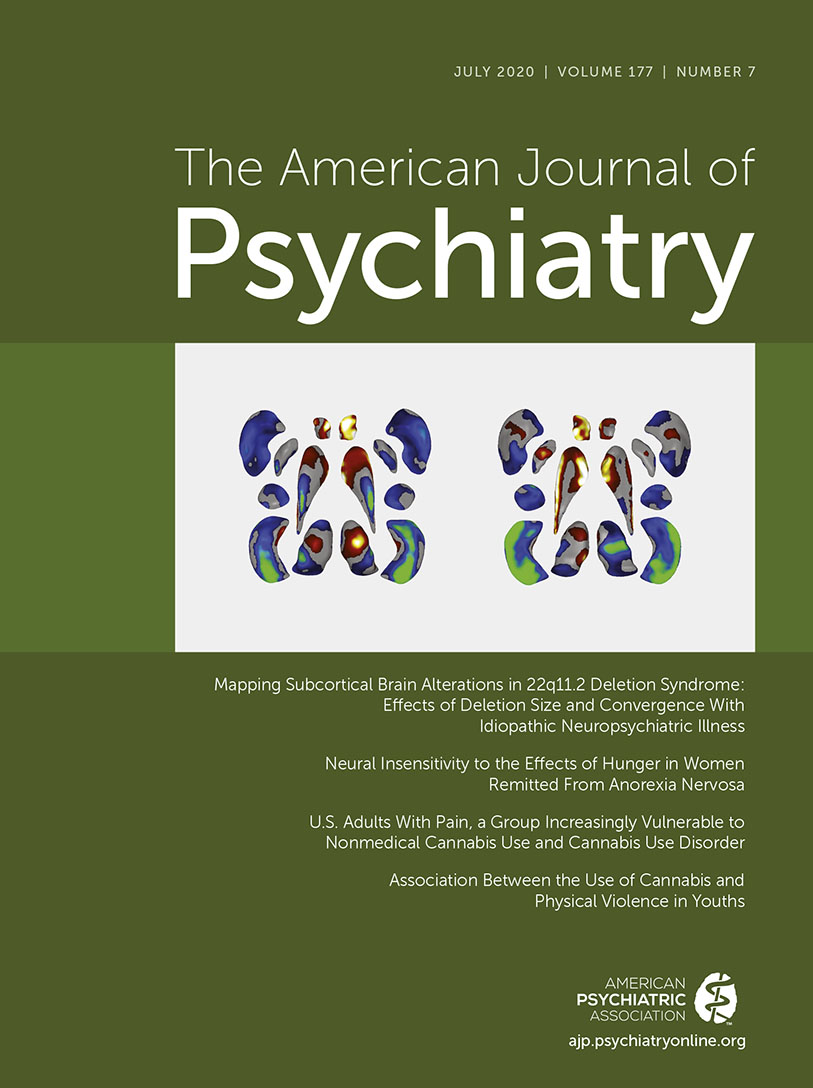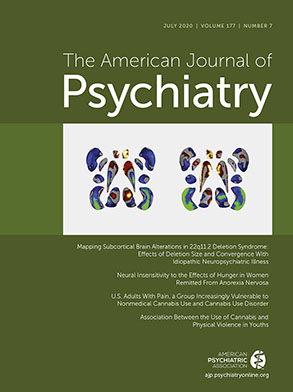While many individuals can use cannabis without harm, evidence indicates that regular or heavy users are at increased risk for health consequences, including vehicle crashes, respiratory symptoms, emergency department visits, psychiatric symptoms, withdrawal, and cannabis use disorder (
1). Despite this evidence, however, U.S. adults have become increasingly likely to perceive cannabis use as harmless (
2), and nonmedical use of cannabis, including daily or near-daily use, has increased among U.S. adults since the early 2000s (
2–
4). The prevalence of adult cannabis use disorder has also increased, including among hospital inpatients (
5), Veterans Health Administration patients (
6), and in one general population study (
4) (although not in another [
2]). Given the evidence for an increase in the prevalence of cannabis use disorder, identifying characteristics that increase the risk of frequent nonmedical cannabis use and cannabis use disorder is an important public health issue. Pain may be one such characteristic.
Pain, an unpleasant sensory-emotional experience associated with actual or potential tissue damage (
7), is common in U.S. adults (
8), is a leading cause of disability (
9), and is associated with substance use disorders (
10,
11). Since 1996, 34 states have passed laws authorizing cannabis use for various medical conditions, including pain, and 11 states have legalized recreational cannabis use. Although meta-analyses of the effectiveness of cannabis to treat pain are inconsistent (
12–
14), 66% of adults now view marijuana as beneficial for pain management (
15). Professional concerns about cannabis use for pain include the risk of unintended consequences, including frequent nonmedical use and cannabis use disorder (
16,
17). Because of the many changes in the marijuana landscape (e.g., more permissive marijuana laws, more favorable public attitudes toward marijuana [
2,
15], and greater nonmedical use [
2–
6]), people with pain may be a group at particular and growing risk for adverse cannabis outcomes, such as frequent nonmedical use and cannabis use disorder. If so, greater clinical and public health efforts to treat or prevent adverse cannabis outcomes among those with pain would be warranted.
To our knowledge, no studies have compared risk for nonmedical cannabis use and cannabis use disorder between those with and without pain in the adult general population, or ascertained whether these risks have changed over time. We used data from two nationally representative surveys of U.S. adults, the 2001–2002 National Epidemiologic Survey on Alcohol and Related Conditions (NESARC) (
18) and the 2012–2013 National Epidemiologic Survey on Alcohol and Related Conditions–III (NESARC-III) (
19), to examine two issues. First, within each survey, we examined whether the prevalence of any nonmedical cannabis use, frequent nonmedical use, and cannabis use disorder differed between respondents with and without pain. Second, given the many changes in the marijuana landscape, we examined whether these differences widened over time, that is, between the 2001–2002 and 2012–2013 surveys.
Discussion
To our knowledge, this is the first study to examine the differences in prevalence of nonmedical cannabis use and cannabis use disorder among U.S. adults with and without pain, and whether the risk differences changed over a period when the prevalence of moderate to severe pain remained similar. In the 2001–2002 survey, any nonmedical cannabis use and cannabis use disorder were more prevalent among respondents with pain than those without pain. In the 2012–2013 survey, the prevalences of all three cannabis outcomes were greater among those with pain than those without pain. Furthermore, when considered in absolute risk terms, the differences between those with and without pain increased over time. Extrapolating to the number of U.S. adults potentially affected, approximately 1.5 million more adults with pain were frequent nonmedical cannabis users in the 2012–2013 period than in the 2001–2002 period, and approximately 0.9 million more adults with pain had past-year cannabis use disorder in the 2012–2013 period than in the 2001–2002 period. These results suggest that among adults with pain, frequent nonmedical cannabis use and cannabis use disorder are growing problems.
Although the risk ratios (multiplicative scale) were unable to capture a significant pain-by-time period interaction for any of the cannabis outcomes, pain-by-time period interactions were found to be significant for all three outcomes using the risk differences (additive scale). Ours is not the first study to find a difference in interaction results depending on the scale used (
44). As discussed further in the Supplemental Material section and Table S6 in the
online supplement, and in a large methodological literature (
31–
45), for a study such as ours, results on the additive scale were the ones of interest, since we were interested in determining whether, during a period of striking changes in the U.S. marijuana landscape, adults in a particular group (i.e., those with pain) were more affected than others. The study findings suggest that in the context of the changing landscape, a shift occurred in the distribution of individuals among whom the cannabis outcomes occurred, and that those with pain are now a group particularly vulnerable to frequent nonmedical use and cannabis use disorder, thus warranting special attention.
While some may question inclusion of a variable representing “any” nonmedical cannabis use as an adverse outcome in a health study, this variable ensures consistency with many other epidemiologic studies of cannabis use that include such a variable (
2,
47), and it is also analogous to the “any” drinking variable in the literature on alcohol (
21,
48). At the same time, frequent nonmedical cannabis use exposes users to risk for adverse medical sequelae such as respiratory symptoms, injury due to intoxication-related impairments, onset of psychiatric disorders including psychotic disorders (
49), and onset of cannabis use disorder (
3,
50). Thus, frequent nonmedical cannabis use and cannabis use disorder are clearly public health concerns. With rates of frequent nonmedical use and cannabis use disorder increasing among U.S. adults (
4–
6,
51), identifying subgroups at particular risk for these conditions is necessary to inform clinical and public health intervention. Our results suggest that adults in pain are one such group.
Given the current U.S. opioid crisis, ecological studies of national U.S. data have examined the relationship of medical marijuana laws to state-level rates of opioid outcomes, finding decreased rates of opioid prescriptions (
52–
56), overdoses (
57,
58), and opioid-related hospitalizations (
59) after medical marijuana law enactment. These studies were interpreted as indicating that increased cannabis availability might help mitigate the opioid crisis. However, ecological studies are a weak design for investigating the causes of individual behaviors (
43,
60–
63), and none of these studies took individual pain or pain-related conditions into account. A large study of U.S. adults showed that among those with pain, cannabis use predicted higher incident nonmedical opioid use and opioid use disorder (
63), and another national study showed that presence of a medical marijuana law predicted increased rates of nonmedical opioid use among 12th graders (
64). These studies, along with the present findings, suggest the need for caution in advocating cannabis as a widespread substitute for opioids in treating chronic noncancer pain.
Sensitivity analyses showed that the results were robust to the influence of several factors, including medical marijuana law status. Results for any and frequent nonmedical cannabis use were consistent across age groups. However, for cannabis use disorder, differences between those with and without pain changed more over time among young adults (the 18- to 29-year age group) than among older groups. Replication of this finding would be useful, as would a study examining whether the result is an age, period, or cohort effect.
Popular beliefs hold that cannabis is an effective treatment for pain (
15,
65), although meta-analyses of cannabis for treating pain (
12,
13) show mixed efficacy, particularly for cannabis consumed in plant form (
13). Further research with stronger designs may support public beliefs about cannabis or its constituent components as treatment for pain. Meanwhile, the need remains for other interventions to manage pain that do not incur the risk of another substance use disorder (i.e., cannabis use disorder) as an adverse treatment outcome.
Limitations of the study should be noted. Pain was indicated by a single variable rather than by physician assessment. However, NESARC and NESARC-III estimates of pain prevalence were nearly identical to National Health Interview Survey estimates (20.4%) (
66), which are based on a well-validated pain scale (
67). Future national surveys of substance use should measure pain and painful medical conditions more extensively. Cannabis variables were based on self-report and thus subject to social desirability bias. The NESARC did not ask about cannabis use exclusively for medical purposes (i.e., no nonmedical use). NESARC-III asked about this, finding that of the 36,309 participants, 82 used cannabis exclusively for medical purposes (
68). These individuals were more likely to have pain than those whose used cannabis solely for nonmedical purposes and those who used it medically and nonmedically (
68). We did not include exclusively medical users in our analyses because they were not asked frequency of use or cannabis use disorder items; future studies should do so. Given the cross-sectional nature of the surveys, we could not address the possibility that cannabis use caused pain, although this appears unlikely, or that initial cannabis use for pain eventually led to cannabis use disorder, which should also be examined in the future. Future studies should also incorporate information on state prescription opioid policies and use of opioids as prescribed and nonmedically. Also, as household surveys, NESARC and NESARC-III did not include participants who were medically institutionalized (a group possibly less likely to be nonmedical marijuana users) or incarcerated (a group possibly more likely to be users), and our findings cannot be generalized to these special populations. Also, NESARC-III compensated participants for participation, whereas NESARC did not. How compensation might have affected responses is unknown, although survey methodology studies suggest little effect of compensation on data accuracy (
69). Additionally, NESARC interviewers were U.S. Census Bureau employees, whereas NESARC-III interviewers were Westat employees. Some have speculated on whether participant willingness to report cannabis use varied by whether their survey interviewer was directly employed by the federal government (
70). However, the fact that participants in both surveys were informed of the governmental sponsor (NIAAA) may have mitigated this possibility.
This study did not address potential mechanisms of the results, including increasingly positive attitudes toward cannabis use, increasing public beliefs that cannabis effectively treats pain, changes in state marijuana laws, and increasing prevalence of conditions that may covary with pain and cannabis use, for example, psychiatric disorders. All of these should be examined in future studies. Finally, a higher response rate in NESARC-III would have been preferable, as survey participants may be healthier than nonparticipants (
71). However, the NESARC-III rate resembled other contemporaneous national surveys, and sample weights adjusted the findings to represent the overall general population.

